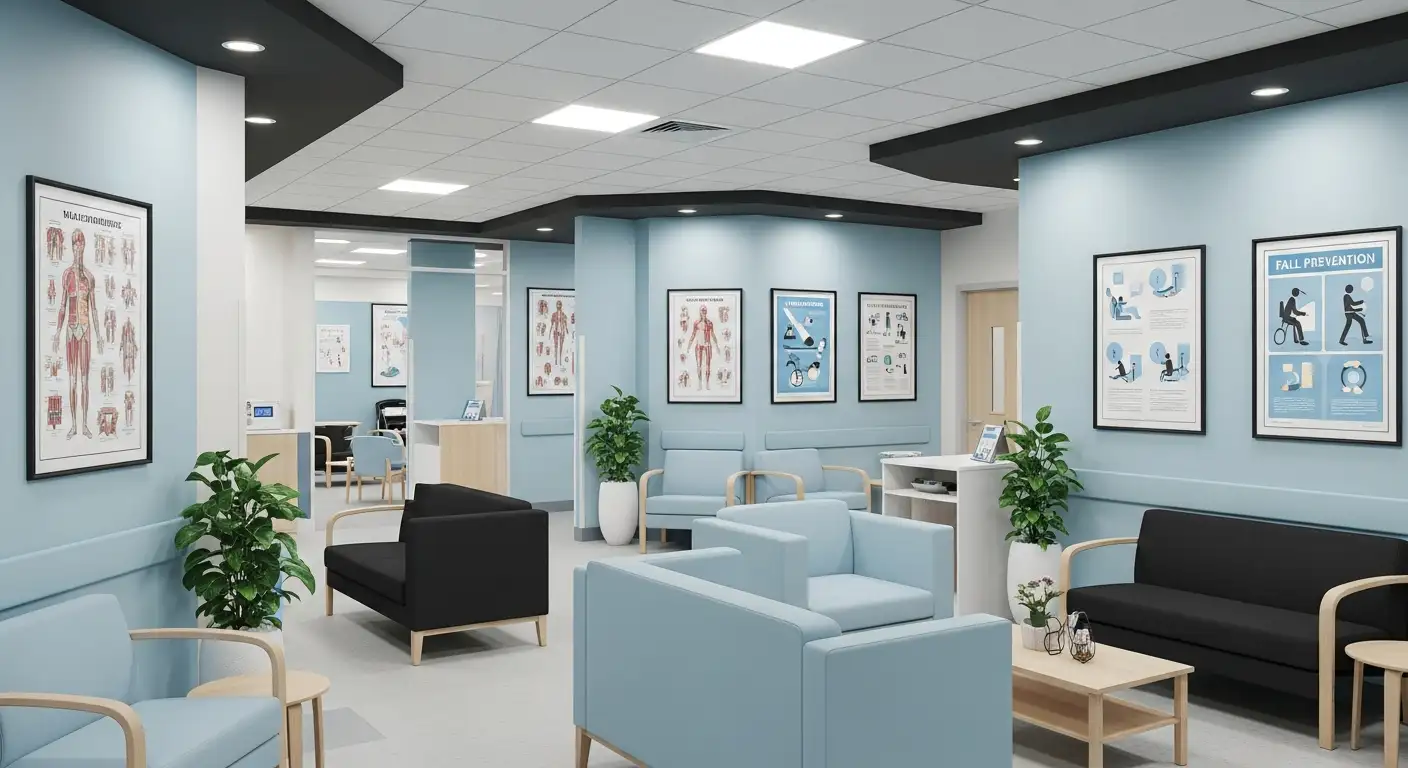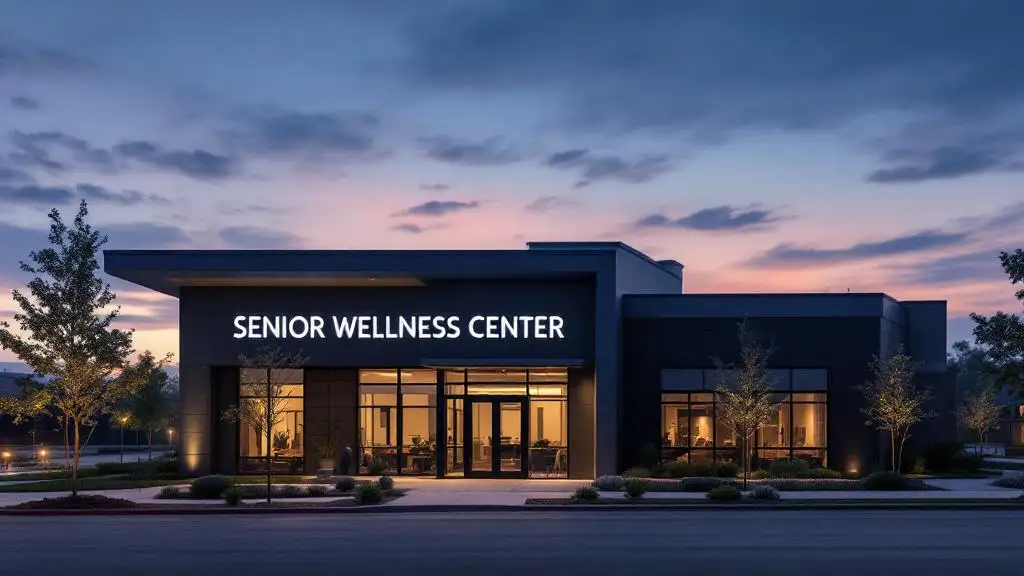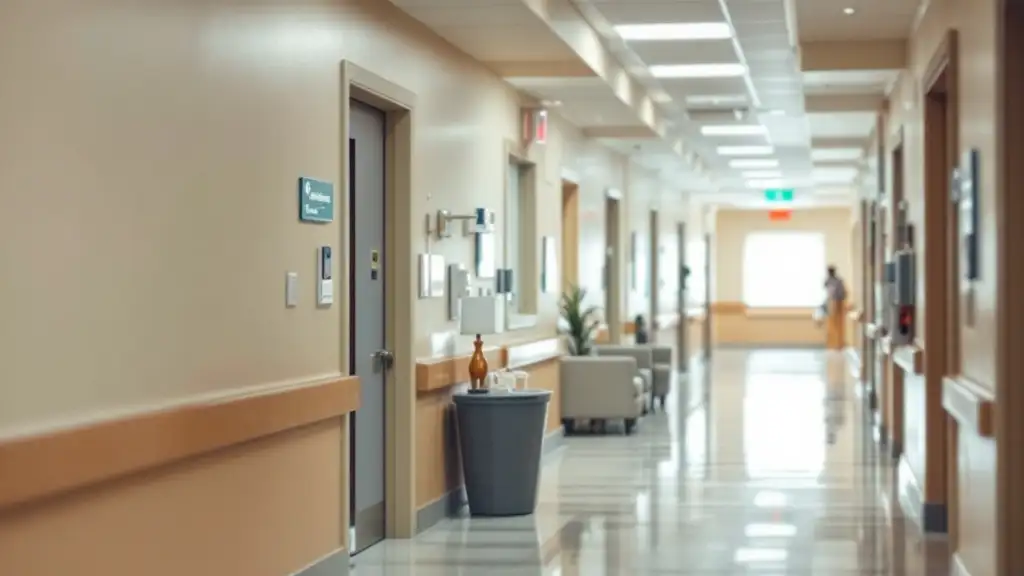The Rising Importance of Mental Health Monitoring in Geriatric Care
As the global population ages, mental health in older adults becomes an increasingly critical focus for healthcare providers. Aging brings unique challenges including higher prevalence of depression, anxiety, cognitive impairments, and substance misuse, which often manifest differently than in younger populations. Effective monitoring and tracking of mental health outcomes in geriatric care are essential for timely intervention and improved quality of life. This article explores the best practices, validated screening instruments, and integrative treatment approaches that are shaping how clinicians address mental health among older adults, supporting comprehensive care tailored to their complex needs.
Understanding Geriatric Mental Health Challenges
Prevalence of Mental Health Conditions in Older Adults
Older adults face a growing burden of mental health issues, including depression, anxiety, dementia, and suicidal ideation. These conditions are common and often underrecognized due to their subtle or overlapping symptom presentations. The aging population (65+) increasingly presents with these disorders, contributing to complex healthcare needs.
Complex Presentation of Symptoms
Mental health conditions in this age group frequently manifest with somatic complaints, functional decline, or cognitive changes rather than classic psychological symptoms. This complexity challenges accurate screening and diagnosis, requiring sensitive, age-appropriate assessment tools like the Geriatric Depression Scale (GDS) and Mini-Mental State Examination (MMSE).
Common Disorders in Older Adults
Depression and anxiety are widespread and may be complicated by co-occurring substance misuse, including alcohol and prescription medications such as benzodiazepines and opioids. Dementia and cognitive impairment also pose significant challenges that intersect with mental health. Suicidal ideation demands careful assessment, especially given the higher suicide rates observed in older adults.
What forms of addiction are commonly treated in specialized programs?
Older adults commonly misuse substances such as alcohol, prescription drugs (including opioids and benzodiazepines), and increasingly cannabis. These addictions often coexist with mental health disorders like depression, anxiety, PTSD, and cognitive impairments. Specialized programs integrate treatment for both behavioral and substance addictions, recognizing the need for tailored approaches in this population.
What are the comprehensive treatment services available for substance abuse and addiction?
Treatment for older adults incorporates medical management attuned to age-related pharmacokinetic changes, behavioral therapies such as cognitive-behavioral therapy and motivational interviewing, medication-assisted interventions, and support from community and family programs. These comprehensive services emphasize holistic care, addressing physical health, mental wellness, social support, and functional ability to improve recovery outcomes.
Key Screening Tools for Mental Health in Older Adults
What are the primary tools used for mental health screening in older adults?
Screening older adults for mental health and cognitive impairments requires validated and reliable tools tailored to the unique presentations in this population. The Geriatric Depression Scale (GDS) and the Patient Health Questionnaire (PHQ-9) effectively screen for depression, which often manifests with somatic symptoms and functional changes in older adults.
For assessing cognitive function, the Mini-Mental State Examination (MMSE) and the Montreal Cognitive Assessment (MoCA) are commonly used to detect cognitive impairments ranging from mild cognitive decline to dementia.
How is PTSD and cognitive impairment screened?
Older adults may also suffer from trauma-related disorders like PTSD, which can complicate the clinical picture. Tools such as the PTSD Checklist (PCL) provide a sensitive measure for trauma-related symptoms. Screening for these conditions supports comprehensive care planning.
What forms of addiction are commonly treated in specialized programs?
In addition to substance use, screening tools help identify co-occurring mental and neurocognitive disorders commonly treated in specialized programs for older adults. These programs use such assessments to tailor interventions effectively, considering overlapping symptoms between substance misuse and mental health conditions.
Why is using validated instruments important?
Employing standardized, validated screening instruments ensures accurate identification of mental health issues and cognitive decline, allowing clinicians to address complex care needs and monitor treatment outcomes in this vulnerable demographic.
Comprehensive Screening for Substance Misuse Among Older Adults
What screening tools are effective for older adults?
Several validated tools are tailored to detect substance misuse among older adults. The Short Michigan Alcohol Screening Test-Geriatric version (SMAST-G) is specifically designed for this age group, accounting for unique patterns and risks. Additionally, common screening instruments such as AUDIT-C and CAGE-AID have proven useful in identifying problematic alcohol and drug use among seniors.
How is prescription drug misuse identified?
Screening for prescription drug misuse—especially concerning benzodiazepines, opioids, and cannabis—is critical since these substances are frequently misused by older adults. Early detection through age-appropriate tools can help prevent dangerous interactions and adverse health outcomes.
What are typical substance use patterns in older adults?
Older adults commonly misuse alcohol and prescription medications, with increasing cannabis use largely driven by medical needs, such as managing pain, sleep disturbances, and anxiety. These patterns differ from younger populations and require sensitive assessment approaches.
What challenges exist in screening this population?
Mental health symptoms in older adults often present somatically or overlap with cognitive changes, complicating diagnosis. Furthermore, screening is frequently overlooked, increasing risk due to physiological changes like slowed metabolism and increased sensitivity to substances. Cultural competence and non-stigmatizing language are essential in ensuring accurate assessments.
What addiction forms are commonly treated in specialized programs?
Substance misuse in older adults includes alcohol, illicit drugs, and prescription medication abuse. Programs specialized for this demographic adapt treatment strategies considering these distinct risk profiles, emphasizing comprehensive screening and integrated care.
| Screening Tool | Purpose | Notes |
|---|---|---|
| SMAST-G | Alcohol misuse in older adults | Tailored for geriatric population |
| AUDIT-C | Alcohol consumption | Brief and efficient screening |
| CAGE-AID | Alcohol and drug use | Modified for broader substance screening |
| Prescription Drug Screens | Misuse of prescribed medications | Focus on opioids, benzodiazepines, and cannabis |
The Impact of Physiological Changes on Substance Processing in Aging
How Do Decreased Muscle Mass and Liver Function Affect Substance Processing?
As people age, natural physiological changes occur that significantly alter how substances are metabolized in the body. Two primary factors are the decrease in muscle mass and diminished liver function. Muscle tissue plays a role in distributing drugs throughout the body, so a reduction means substances can linger longer in the bloodstream. Simultaneously, liver function declines, reducing the body’s ability to break down medications and substances efficiently. This slower metabolism increases the risk of accumulation and toxicity.
Why Are Medication Interactions More Common Among Older Adults?
Older adults often take multiple medications, increasing the potential for drug interactions. The altered metabolism caused by aging heightens sensitivity to these interactions. When the liver’s enzymatic activity changes, the processing of one drug can be affected by another, potentially leading to harmful effects. This makes careful medication review and monitoring essential in treatment planning.
What Risk Factors Are Associated with These Physiological Changes?
The physiological changes in aging increase susceptibility to adverse events such as falls and cognitive decline. For example, substances can cause greater sedation or dizziness, raising fall risk — a critical concern for older individuals. Similarly, cognitive impairments may be exacerbated by drug accumulation or interactions, complicating diagnosis and treatment of mental health and substance use disorders.
How Do These Changes Influence Treatment Planning?
Treatment for older adults must account for these physiological factors by using age-appropriate screening tools and careful medication management. Providers often tailor interventions with lower doses, slower titration, and ongoing assessment to prevent adverse effects. Incorporating this understanding into holistic care supports safer and more effective treatment outcomes for aging populations with substance use concerns.
Integrated Screening Approaches for Co-occurring Disorders
How are mental health and substance abuse treatment integrated in comprehensive care?
Integrated screening approaches are essential for early detection and coordinated management of co-occurring mental health and substance use disorders, especially in older adults. Because symptoms of mental health conditions like depression, anxiety, PTSD, and cognitive impairments often overlap with those of substance misuse, using combined screening tools enhances diagnostic accuracy and tailors treatment effectively.
Overlap of mental health and substance misuse symptoms
Older adults frequently exhibit overlapping symptoms such as somatic complaints, cognitive changes, mood disturbances, and functional decline that may mask either mental health disorders or substance misuse. This overlap complicates diagnosis and necessitates comprehensive evaluation to identify all contributing factors.
Use of combined screening measures (GDS, PHQ-9, PTSD Checklist)
Validated screening instruments like the Geriatric Depression Scale (GDS), Patient Health Questionnaire-9 (PHQ-9), and PTSD Checklist are integrated into assessment protocols to capture mental health status alongside substance use patterns. Additionally, substance misuse screening tools such as AUDIT-C and SMAST-G complement these mental health measures to provide a full clinical picture.
Importance of holistic assessment
Holistic assessment includes evaluating physical health, cognitive function, social support, medication use, and psychosocial risks. It incorporates multiple information sources, including self-reports, clinical interviews, and collateral data, to guide personalized treatment planning. This approach supports comprehensive care by addressing the interconnected nature of mental health and substance misuse challenges.
By implementing integrated screening, healthcare providers can improve treatment outcomes and help older adults manage co-occurring disorders more effectively in a patient-centered, culturally competent manner.
Screening for Elder Abuse and Its Mental Health Impact
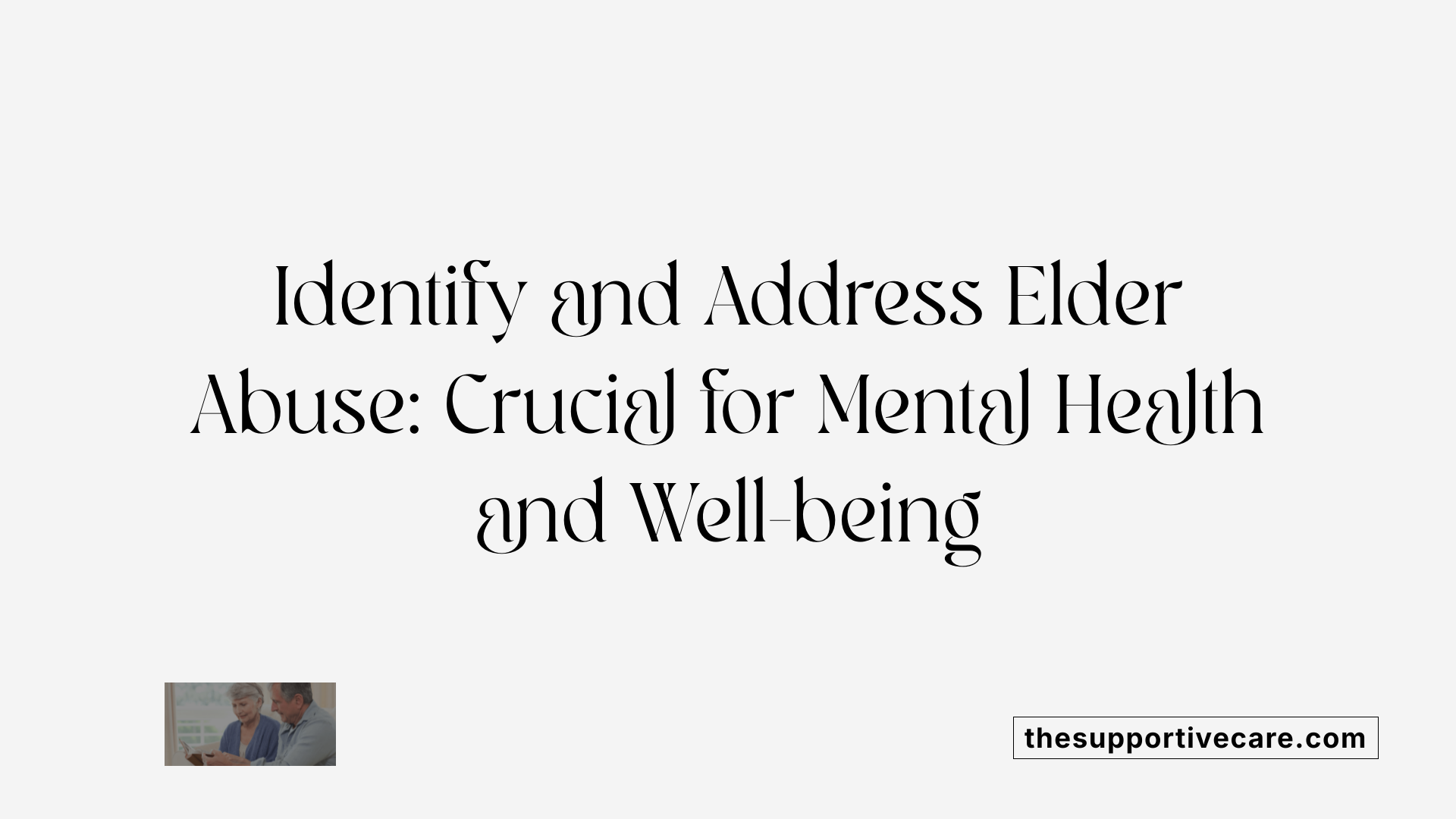
Use of Elder Abuse Suspicion Index (EASI)
Screening for elder abuse is a crucial component of comprehensive care for older adults, especially considering its significant links to mental health and substance misuse. The Elder Abuse Suspicion Index (EASI) is a validated, straightforward tool designed specifically to help clinicians identify potential abuse in elderly patients. It involves a brief questionnaire that can be easily administered in various healthcare settings, enabling early detection of physical, emotional, or financial abuse.
Relationship between Abuse, Mental Health, and Substance Misuse
Research highlights a strong correlation between elder abuse and adverse mental health outcomes. Victims often exhibit higher rates of depression, anxiety, post-traumatic stress disorder (PTSD), and cognitive impairments. Moreover, exposure to abuse tends to increase the risk of substance misuse as a coping mechanism. This overlapping burden necessitates integrated screening processes that address both the physical safety and psychological well-being of older adults.
Importance of Routine Elder Abuse Screening
Routine screening for elder abuse should be a standard practice in all healthcare interactions with older adults. Early identification allows for timely intervention, which can mitigate the progression of mental health decline and reduce the potential for substance misuse. Incorporating elder abuse assessments alongside mental health and substance use evaluations ensures a holistic understanding of the patient’s needs and fosters safer, more effective treatment strategies.
Monitoring Mental Health Treatment Outcomes Using Progress Monitoring (PM)
What are the principles and benefits of PM?
Progress Monitoring (PM) involves systematic measurement and feedback during treatment to track patient progress. It helps clinicians quickly identify when interventions are effective or need adjustment. This ongoing approach supports personalized care and prevents treatment stagnation.
How do traditional indicators compare with advanced measurement tools?
Traditionally, PM in substance use disorder (SUD) treatment relied on attendance and urine drug screens. While useful, these indicators provide limited insight into broader treatment outcomes. Advances include diverse psychological and behavioral assessment tools that capture changes in symptoms, functioning, and quality of life, offering a more comprehensive view.
How effective is PM in mental health and SUD treatment?
Research, including meta-analyses, demonstrates that PM significantly improves treatment outcomes in mental health care. In SUD treatment, integrating comprehensive monitoring tools enhances effectiveness beyond basic attendance measures. Increased use of PM is encouraged to optimize patient outcomes in these fields.
Behavioral Activation Therapy for Depression in Older Adults
Theory and Evidence Base for Behavioral Activation (BA)
Behavioral activation is an evidence-based therapy designed to treat depression by encouraging individuals to engage in meaningful and rewarding activities. It operates on the principle that increased engagement in positive experiences can counteract the withdrawal and inactivity common in depression. Clinical trials, including studies with older adults, demonstrate that BA reduces depressive symptoms and promotes better mood through structured activity scheduling and problem-solving.
Reducing Avoidance and Increasing Engagement
One of the central goals of BA is to reduce avoidance behaviors that maintain depressive symptoms. In older adults, avoidance may stem from physical limitations, loss, or social isolation, exacerbating depression. BA helps overcome these barriers by gradually increasing activity levels tailored to individual capabilities and interests, fostering a renewed sense of purpose and accomplishment.
Benefits Specific to the Aging Population
For older adults, BA offers unique advantages. It supports overcoming age-related challenges such as mobility issues and social withdrawal by promoting structured routines and social interaction. This therapy also aligns well with the behavioral health integration model, collaborating with healthcare providers to address both mental health and physical needs. BA contributes to improved quality of life, better mood, and can assist in managing co-occurring substance use, as depression often intersects with addiction in late life.
Addressing Substance Abuse and Addiction
Behavioral therapies like BA are vital components of comprehensive treatment services for substance abuse and addiction. They address underlying depressive symptoms that may hinder recovery and provide coping strategies that facilitate sustained abstinence and relapse prevention in older populations.
Pharmacotherapy and Medication Management in Geriatric Mental Health
Age-related pharmacokinetic changes
As people age, their bodies process medications differently due to changes in metabolism, organ function, and body composition. For instance, decreased liver function slows drug metabolism, while reduced kidney function impairs drug elimination. These physiological shifts increase the risk of medication accumulation and toxicity. Hence, clinicians must adjust dosages carefully to account for altered absorption, distribution, metabolism, and excretion in older adults.
Medication considerations to avoid adverse effects
Older adults are particularly vulnerable to adverse drug effects such as sedation, falls, and cognitive impairment. To minimize these risks, medications should be selected with a preference for those with safer profiles and lower anticholinergic burdens. Close monitoring is essential to identify side effects early, and psychoactive drugs should be used cautiously, emphasizing non-pharmacological interventions like behavioral activation when possible.
Managing polypharmacy and drug interactions
Polypharmacy—the use of multiple medications—is common in older populations and increases the risk of harmful drug-drug interactions. Comprehensive medication reviews need to be routine, assessing all prescriptions and over-the-counter drugs to identify potential interactions and reduce unnecessary medications. Coordination among healthcare providers is vital for optimizing safety and efficacy in pharmacotherapy for geriatric mental health.
Harm Reduction Strategies Tailored for Older Adults
Moderation and Safety Counseling
Harm reduction in older adults emphasizes moderation and safety counseling to minimize the risks associated with substance misuse. Unlike abstinence-only approaches, moderation strategies encourage safer substance use patterns, considering the physiological changes in older adults that affect metabolism and drug interactions. Counseling focuses on educating older patients about the heightened risks of alcohol and drug consumption, with an emphasis on practical steps to reduce harm while respecting their autonomy.
Managing Prescription Drug Misuse
Prescription drug misuse is a significant concern in older populations, especially with medications like benzodiazepines, opioids, and cannabis. Harm reduction includes careful medication management, monitoring for signs of misuse or dependence, and educating patients about safe usage and potential interactions. Clinicians are encouraged to use nonjudgmental communication to encourage disclosure and adherence to safer use protocols.
Reducing Fall Risk and Other Harms
Falls and cognitive decline are critical risks linked to substance misuse in older adults. Harm reduction approaches integrate assessment tools to identify fall risk and promote interventions such as balance training, home safety evaluations, and medication adjustments. Firearm safety counseling using frameworks like the 3 A’s—Ask, Assess, Assist—is also vital. Addressing sleep disturbances and social isolation complements harm reduction by enhancing overall safety and well-being.
These tailored strategies reflect a comprehensive, age-sensitive approach that supports older adults in managing substance use while reducing harm in ways that respect their unique health profiles and life contexts.
Addressing Firearm Safety in Mental Health Risk Assessment
How is the 3 A’s framework used in firearm safety screening?
The 3 A’s framework provides a structured approach for clinicians to assess firearm safety in older adults. It involves three critical steps: Ask about access to firearms, Assess the risk of harm, and Assist in safety planning. This method helps identify individuals at risk and promotes proactive interventions to reduce the likelihood of firearm-related injuries or deaths.
What clinician interventions support firearm safety for older adults?
Clinicians play a crucial role in enhancing safety by engaging in nonjudgmental conversations regarding firearm access and storage. Interventions include counseling patients and families about safe firearm storage practices, discussing the risks associated with cognitive decline or mental health disorders, and collaborating with caregivers when appropriate. These efforts are essential in mitigating risks, especially among older adults with conditions like depression or cognitive impairment.
How does screening enhance safety in geriatric mental health care?
Integrating firearm safety screening into routine geriatric mental health assessments allows early identification of potential risks. Screening tools complement broader evaluations addressing depression, substance use, and cognitive status. By identifying firearm access alongside mental health factors, clinicians can tailor interventions that foster safer environments and support overall well-being in older populations.
Cultural Competence in Geriatric Mental Health Screening and Treatment
Incorporating ethnicity, language, and socioeconomic factors
Effective geriatric mental health and substance abuse treatment requires the thoughtful incorporation of cultural elements such as ethnicity, language proficiency, and socioeconomic status. These factors influence how symptoms present, how patients interpret their experiences, and their comfort with disclosure. Assessments and treatment plans that acknowledge these dimensions can better address the unique needs of diverse populations.
Reducing stigma through sensitive language
Language shapes patient engagement. Using nonjudgmental and respectful terminology helps reduce stigma associated with mental illness and substance misuse, encouraging older adults to seek and remain in treatment. Care providers are advised to adopt communication styles that validate patient experiences while avoiding labels that may alienate or discourage participation.
Adapting screening tools for diverse populations
Many standard screening instruments have been developed and validated primarily in specific demographic groups. Adapting and selecting tools that account for cultural differences—such as language translation, cultural norms, and health beliefs—enhances the accuracy of screening outcomes. Resources exist to guide clinicians in choosing appropriate instruments sensitive to diverse ethnic and socioeconomic backgrounds.
How are mental health and substance abuse treatment integrated in comprehensive care?
Culturally competent care is a cornerstone of integrated mental health and substance abuse treatment for older adults. By tailoring assessments and interventions to the cultural context of each individual, providers improve treatment relevance and effectiveness. This integration supports holistic patient-centered care, enhancing outcomes for diverse older populations in need of multifaceted support.
Specialized Considerations for Screening Pregnant Women and Other High-risk Groups
What are TWEAK and T-ACE tools for prenatal screening?
TWEAK and T-ACE are screening instruments specifically designed to identify risky alcohol use in pregnant women, helping healthcare providers intervene early to prevent harm to both mother and fetus. TWEAK focuses on tolerance, worry, eye-openers, amnesia, and knowledge about drinking, while T-ACE highlights tolerance, annoyance, cut down attempts, and eye-openers. These tools are widely recommended for prenatal screening due to their sensitivity and specificity in detecting potential alcohol-related problems during pregnancy.
How do screening approaches address disability and unique risk factors?
Screening protocols must consider the diverse needs of women with disabilities and those facing unique health or social risk factors. Adjustments include using accessible formats and ensuring culturally competent approaches. Tailored screening instruments and thorough assessments help capture complex interactions between substance use, disability status, and environmental challenges. This ensures that treatment environments are inclusive and that interventions effectively address the layered vulnerabilities these women experience.
Why is screening for trauma and sexual victimization important in women?
Women in substance abuse treatment exhibit alarmingly high rates of trauma exposure—ranging from 55% to 99%—including sexual victimization, childhood abuse, and interpersonal violence. Screening for trauma and post-traumatic stress disorder (PTSD) using validated tools such as the PTSD Checklist (PCL) is critical. These evaluations allow clinicians to understand trauma-related symptoms that profoundly influence treatment engagement and outcomes. Addressing trauma through comprehensive screening leads to more sensitive, trauma-informed care and supports recovery tailored to women's unique experiences.
What forms of addiction are commonly treated in specialized programs?
Specialized screening tools and protocols are essential for pregnant women and other vulnerable populations to tailor addiction treatment programs appropriately. Through such tools, programs often address alcohol use disorders, drug dependencies, trauma-related substance misuse, and co-occurring mental health conditions among women who face heightened risks.
| Screening Focus | Tools & Protocols | Purpose and Population |
|---|---|---|
| Prenatal Alcohol Use | TWEAK, T-ACE | Detect risky drinking in pregnant women for early intervention |
| Disability & Specific Risks | Adapted screening and accessible tools | Ensure comprehensive assessment of multifactorial challenges |
| Trauma & Sexual Victimization | PTSD Checklist (PCL), sexual abuse screening | Identify trauma symptoms for trauma-informed treatment |
Screening Tools for Trauma and PTSD in Women Undergoing Substance Abuse Treatment
PTSD Checklist (PCL-C and PCL-M)
The PTSD Checklist is a validated screening tool widely utilized to assess trauma and PTSD symptoms in women undergoing substance abuse treatment. There are two versions: the PCL-C for civilians and the PCL-M for military populations. These instruments help clinicians identify the presence and severity of PTSD, enabling tailored treatment planning.
High Prevalence of Trauma Exposure
Trauma is highly prevalent among women in substance abuse programs, with research showing that 55-99% have experienced trauma or abuse. This startling rate underscores the critical need for effective trauma screening to detect underlying conditions that may influence substance use patterns.
Importance of Trauma-Informed Care
Given the high incidence of trauma in this population, trauma-informed care is essential. Screening for sexual victimization, childhood abuse, and interpersonal violence provides a foundation for sensitive and comprehensive treatment. A trauma-informed approach fosters trust, supports recovery, and addresses the complex interplay between trauma and substance abuse in women.
SBIRT: An Evidence-Based Framework for Substance Use Screening and Intervention
What Are the Principles of SBIRT?
SBIRT, which stands for Screening, Brief Intervention, and Referral to Treatment, is an evidence-based public health approach designed to identify individuals at risky levels of alcohol and drug use. Its goal is early detection to prevent health consequences, disease, accidents, and injuries. The process combines universal screening with brief counseling and guidance tailored to the severity of substance use. Referral to specialized treatment is provided when necessary. SBIRT thus serves as a proactive strategy that complements comprehensive treatment services by bridging early intervention and long-term care.
How Is Universal Screening Implemented Across Settings?
A notable strength of SBIRT is its adaptability across diverse settings. It can be administered by a variety of staff in locations such as clinics, schools, community centers, and primary care offices. The universal screening approach ensures that all individuals, regardless of demographic or risk factors, undergo initial substance use screening. This inclusive strategy is critical for early identification of misuse before more severe problems develop.
What Screening Tools Are Used for Diverse Populations Including Older Adults?
SBIRT utilizes a range of validated screening tools tailored to specific populations:
- Pre-screening tools: AUDIT-C, DAST-1, NIAAA Single Alcohol Screening Question (SASQ), NIDA Single Question, SUBS.
- Adult tools: AUDIT, ASSIST, DAST-10, CUDIT-R.
- Adolescents: CRAFFT, S2BI, NIAAA Youth Screen, BSTAD.
- Older adults: SMAST-G, AUDIT-C, and CAGE-AID help detect substance misuse, which is critical as older adults often experience under-screening.
- Pregnant women: Five P’s, T-ACE, and TWEAK address unique risks and sensitivities in prenatal care.
These instruments can be self-administered or conducted via interview and are validated to detect varying degrees of substance use severity.
SBIRT training is widely accessible through classroom and online formats, with support materials like pocket cards and handouts enhancing practitioner and patient education. Integration manuals and billing guides also facilitate embedding SBIRT into comprehensive substance abuse, mental health, and addiction programs.
Training and Resources for Effective SBIRT Implementation
Classroom and Online Training Options
Training for SBIRT (Screening, Brief Intervention, and Referral to Treatment) is widely accessible, designed to accommodate diverse learning preferences and settings. Both classroom-based sessions and online courses offer comprehensive instruction on how to effectively conduct screenings, deliver brief interventions, and manage referrals. These training formats ensure staff across clinics, schools, community centers, and various healthcare environments can develop proficiency in SBIRT.
Medicaid Billing Compliance
Another important component of SBIRT training includes education on Medicaid billing requirements. Providers and organizations receive clear guidelines on how to document and bill for SBIRT services to secure reimbursement efficiently. This compliance training supports sustainable integration of SBIRT into routine care.
Practical Materials Like Pocket Cards and Handouts
Complementing training are educational resources designed for quick reference and patient education. Pocket cards summarize screening tools and intervention steps in a concise format, making them handy during clinical encounters. Handouts for participants provide information about risks associated with alcohol and substance use and encourage engagement in treatment. These practical materials enhance both clinician confidence and patient understanding.
Together, these training and resource offerings create a solid foundation for the successful delivery of SBIRT, promoting early identification and intervention in substance use issues across populations.
Behavioral Health Integration (BHI) to Improve Geriatric Care

How are mental health and substance abuse treatment integrated in comprehensive care?
Behavioral health integration (BHI) represents a systematic collaboration between primary care and behavioral health providers. This approach involves coordinated teams working closely with patients and their families to deliver patient-centered care that addresses both mental health and substance use disorders concurrently.
Collaborative care models
Collaborative care models, as demonstrated by initiatives like the IMPACT trial, significantly improve treatment outcomes for older adults. These models emphasize regular communication among healthcare professionals, shared decision-making, and integrated treatment plans that target co-occurring mental health and substance misuse challenges. More than 50% of older adults in such programs show symptom improvement within a year.
Patient-centered care involving families
Involving families in the treatment process enhances support networks for older adults, increases treatment adherence, and improves overall quality of life. Patient-centered care recognizes individual strengths, coping styles, and beliefs, which are vital for effective recovery and reducing stigma.
Benefits for mental health and substance misuse treatment
Integrating behavioral health into geriatrics fosters early detection through routine screening and comprehensive assessment, including medication management and psychosocial support. This coordinated approach helps manage complex presentations and overlapping symptoms commonly seen in older adults, ultimately leading to better mental health outcomes and more effective substance misuse treatment.
Prevalence and Trends of Substance Use Disorder in Older Adults
Rising rates of alcohol and cannabis use
Alcohol remains the most commonly misused substance among older adults, followed by cannabis. From 2015 to 2018, cannabis use among adults aged 65 and older surged by 75%, primarily for medical purposes such as pain relief, arthritis symptoms, sleep issues, anxiety, and depression. This trend reflects a shift in substance use patterns tied to chronic health management rather than recreational use.
Increased emergency room visits linked to cannabis
The rise in cannabis consumption has been accompanied by a dramatic increase in cannabis-related emergency room visits among older adults—an escalation of 1,804%. Contributing factors include higher concentrations of THC in modern cannabis strains and the physiological vulnerabilities of aging individuals. These visits underscore the need for careful screening and education about cannabis use in this population.
Gender and racial disparities in opioid overdose risk
Older adults with a history of opioid use disorder or those prescribed opioids post-medical procedures are particularly vulnerable to overdose. Notably, older Black men face a higher risk, highlighting important racial and gender disparities. These differences call for targeted interventions and culturally sensitive care approaches to reduce overdose incidents and improve outcomes for at-risk groups.
Understanding Motivations Behind Cannabis Use Among Older Adults
Medical vs. Recreational Use
Older adults primarily use cannabis for medical reasons rather than recreational purposes. Unlike younger adults, who often engage in cannabis use socially, seniors tend to use it to manage chronic health conditions. This distinction is important for healthcare providers when assessing substance use and understanding the context of cannabis consumption among the elderly.
Symptom Management Such as Pain and Anxiety
Symptom relief drives much of cannabis use in this population. Common reasons include managing pain related to arthritis, alleviating sleep disturbances, reducing anxiety, and addressing depression. These symptoms are prevalent among seniors and often lead to cannabis being used as an alternative or supplement to conventional medical treatments.
Implications for Screening and Intervention
Given the motivations tied to medical symptom management, screening in older adults should incorporate questions about cannabis use framed within their health context. Nonjudgmental and educational approaches are recommended to accurately capture use patterns and avoid stigma. Interventions can then be tailored to address the underlying medical or psychological conditions driving cannabis use while monitoring for potential risks like increased emergency visits or drug interactions.
Challenges and Strategies for Routine Substance Use Screening in Primary Care for Older Adults
What are the barriers contributing to under-screening of substance use in older adults?
Under-screening of substance misuse in older adults is a significant challenge largely due to misconceptions that substance use is less common or less problematic in this population. Clinicians may overlook symptoms because they often mimic common aging issues like cognitive decline, physical frailty, or chronic illnesses. Additionally, stigma and lack of tailored screening tools contribute to less frequent assessments. Older adults are also less likely to volunteer information about substance use unless specifically asked.
How can clinicians adopt nonconfrontational, educational approaches to screening?
Effective screening relies on creating a supportive environment that encourages openness. Using educational, nonjudgmental language when discussing alcohol or drug use helps reduce stigma and increases patient comfort. Clinicians are encouraged to normalize screening as routine health care, emphasizing its role in maintaining health and safety. Educating patients on substance use risks specific to aging can foster collaboration rather than confrontation.
What challenges arise from substance misuse symptoms overlapping with aging-related health conditions?
Symptoms of substance misuse such as memory problems, fatigue, sleep disturbances, and mood changes often resemble symptoms of aging, dementia, or other medical conditions, complicating diagnosis. Clinicians must be vigilant in differentiating these to avoid misdiagnosis or missed diagnosis. Comprehensive assessments that incorporate cognitive tests and substance use history are crucial to accurately identify substance misuse.
Combining routine, age-appropriate screening tools like AUDIT-C or SMAST-G with an empathetic, educational approach helps overcome barriers and improves early detection. This approach supports timely intervention and prevention of adverse health outcomes in the older adult population.
Comprehensive Assessments Beyond Screening: Physical, Sleep, and Functional Health
Health History and Physical Examinations
A thorough health history and physical examination are foundational components of comprehensive assessment, particularly for older adults in mental health care. These exams identify chronic illnesses, medication effects, and co-occurring medical conditions that may influence mental health and substance use treatment. Women, due to earlier onset of substance-related health problems, and older adults both benefit from detailed medical evaluations to guide tailored treatment planning.
Sleep Assessments (PSQI)
Sleep disturbances are common in populations with mental health and substance use disorders. The Pittsburgh Sleep Quality Index (PSQI) is a validated screening tool widely used to assess sleep quality and disturbances over a one-month interval. Sleep assessments help clinicians understand the impact of sleep problems on mental health symptoms and overall functioning, allowing for integration of sleep management strategies into treatment plans.
Functional Abilities and Fall Risk Evaluations
Evaluating functional abilities, including Activities of Daily Living (ADLs) and Instrumental Activities of Daily Living (IADLs), provides insight into an individual’s capacity to live independently and manage self-care. Screening for fall risk is critical, especially in older adults, where substance misuse and medication interactions can increase vulnerability. Incorporating fall risk assessments into care supports prevention strategies and informs safety planning.
Comprehensive assessments go beyond mental health symptoms and substance use to include critical physical health, sleep, and functional domains, ensuring holistic and effective treatment approaches.
Family and Community Engagement in Treatment of Older Adults

How is family involvement integrated into substance abuse treatment for older adults?
Family and community engagement plays a vital role in comprehensive treatment services for older adults battling substance abuse and addiction. Inclusion of supportive networks offers critical emotional and practical support that can enhance adherence to treatment plans and foster sustained recovery. Family members often participate in therapy sessions and education programs that help them understand the complex needs of their loved ones.
How does family and community support enhance quality of life and treatment adherence?
Supportive relationships improve quality of life by reducing feelings of isolation and promoting social connectedness, which are important factors in recovery. Community programs provide older adults with opportunities for meaningful social activities and access to resources such as transportation, housing assistance, and healthcare services. These supports enable older adults to maintain stability and reduce risk factors that can lead to relapse.
What role do family and community networks play in relapse prevention?
Ongoing engagement of family and community networks is essential in monitoring early warning signs of relapse and providing timely intervention. These networks can help reinforce behavioral strategies learned during treatment, offer encouragement, and help manage stressors that might trigger substance misuse. Support groups and peer networks within the community also strengthen resilience and provide a sense of belonging.
In summary, family involvement and community programs strengthen comprehensive substance abuse treatment by providing continuous social support essential for successful recovery in older adults. This integrated approach not only helps improve treatment outcomes but also supports overall well-being and long-term sobriety.
Evidence Supporting Better Treatment Outcomes in Older Adults
How Effective Are Tailored Interventions for Older Adults?
Research demonstrates that treatment interventions specifically adapted to older adults' needs can significantly improve outcomes. Approaches like cognitive behavioral therapy (CBT), motivational interviewing, behavioral activation, and medication management tailored to age-related changes show efficacy. These therapies address unique challenges older adults face, such as cognitive decline and medication sensitivities.
How Do Older Adults' Treatment Outcomes Compare to Younger Populations?
Interestingly, evidence suggests that older adults can achieve successful treatment outcomes that are sometimes superior to those of younger adults. Studies indicate that when care is adapted appropriately, older adults may have higher engagement rates and better adherence to treatment plans, resulting in improved recovery trajectories despite complex health needs.
Why Is Age-Appropriate Care So Important?
Age-appropriate care recognizes physiological, psychological, and social factors unique to older adults. Screening tools like SMAST-G and interventions adjusted for slower metabolism and comorbid health conditions help avoid adverse effects and optimize recovery. Holistic assessment—covering physical health, mental health, social support, and functional abilities—enables clinicians to create individualized treatment plans that enhance effectiveness and safety for elderly patients.
This growing evidence underscores the necessity of integrating age-specific screening and treatment strategies to meet the distinct needs of older adults battling substance misuse and co-occurring mental disorders.
SAMHSA Guidelines and TIP 26 for Treating Older Adults with Substance Use Disorders
Recommended interventions like CBT and motivational interviewing
SAMHSA's TIP 26 emphasizes cognitive behavioral therapy (CBT) and motivational interviewing as foundational interventions for older adults with substance use disorders (SUD). CBT helps older adults recognize and change negative thought patterns linked to substance use, while motivational interviewing enhances their readiness and commitment to change through a collaborative, non-confrontational approach. These therapies accommodate the unique psychological and social needs of the aging population, focusing on strengthening coping strategies and fostering engagement in recovery.
Special considerations in pharmacotherapy
Pharmacotherapy for older adults must account for age-related changes in drug metabolism and sensitivity. Medication management requires cautious prescribing to minimize adverse effects, drug interactions, and risks like falls or cognitive impairment. Treatment plans often involve careful titration and monitoring of substances used to manage withdrawal or cravings. SAMHSA highlights the necessity of integrating pharmacological treatment with psychosocial interventions tailored for this population’s increased vulnerability.
Integration with mental health services
Older adults with SUD frequently experience co-occurring mental health conditions such as depression, anxiety, or cognitive impairment. TIP 26 advises an integrated care approach combining mental health and substance use treatment. Collaborative care models promote communication among providers and offer coordinated services addressing both disorders simultaneously. This holistic model improves outcomes by addressing overlapping symptoms, enhancing medication adherence, and supporting psychosocial needs in a patient-centered manner.
Neurological Effects and Ongoing Research into Substance Use in Older Adults

Impact of substances on cognition
Substance use in older adults significantly affects brain health and cognitive functioning. Research shows that removing alcohol and other substances may help protect cognitive abilities and potentially slow down the progression of dementia, including Alzheimer’s disease. Age-related physiological changes make the brain more vulnerable to the neurotoxic effects of drugs, leading to risks such as cognitive decline and impaired memory.
Differences by gender and racial background
Emerging studies underscore that neurological responses to substances can vary by gender and racial background. For instance, older Black men with a history of opioid use disorder demonstrate heightened overdose risks, indicating the need for tailored approaches. Gender differences also play a role in substance effects and recovery trajectories, highlighting the importance of culturally competent care and targeted screening.
Implications for refining interventions
Understanding these neurological effects and subgroup differences informs the creation of more effective, personalized treatment plans. Ongoing research aims to refine interventions by accounting for unique biological and social factors among older adults. This approach strives to optimize outcomes, reducing cognitive harm and enhancing quality of life in this growing population segment.
Utilizing Digital Tools and Electronic Health Records in Geriatric Mental Health Monitoring
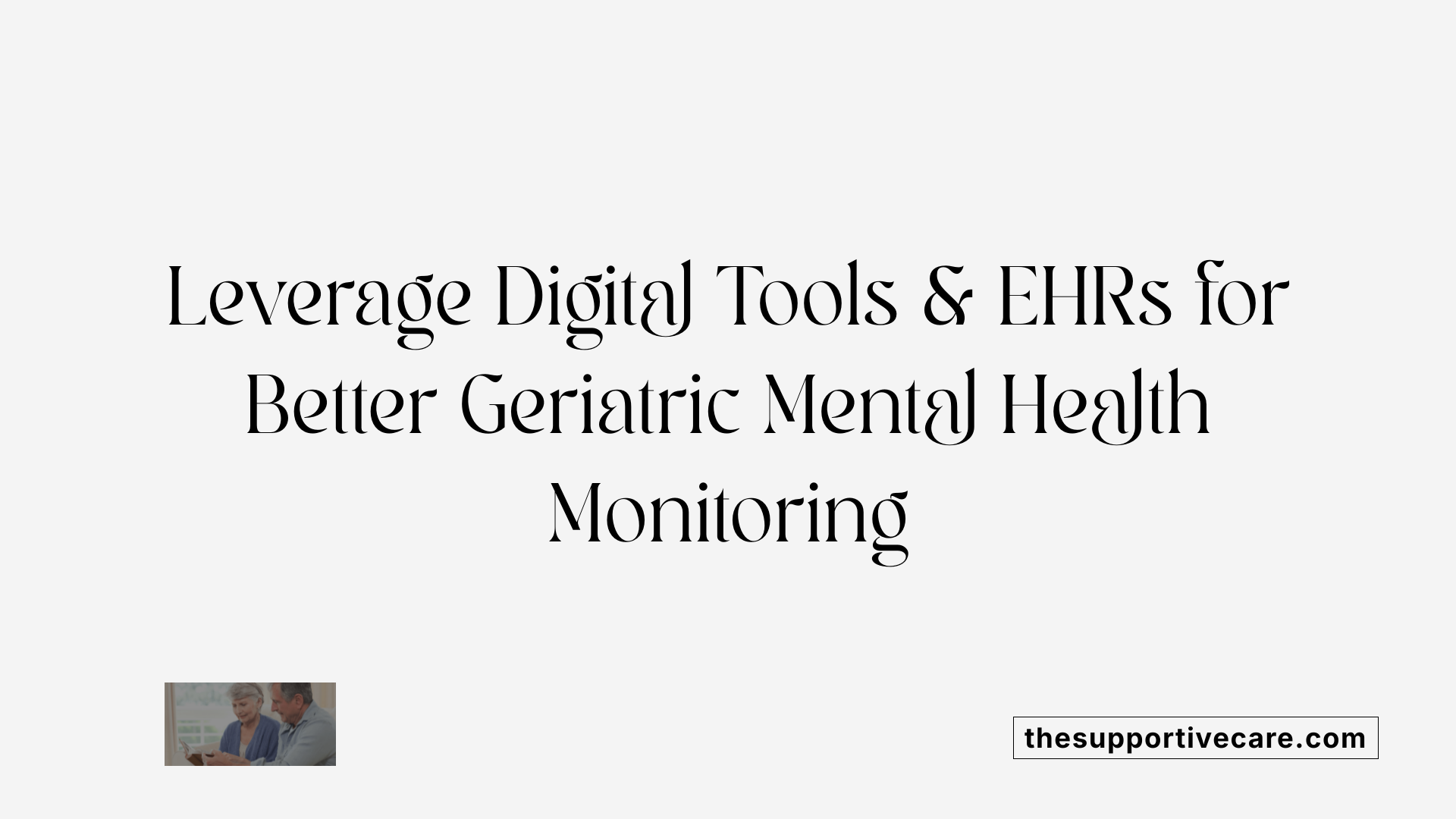
How are mental health and substance abuse treatment integrated in comprehensive care?
Digital tools and electronic health records (EHRs) play a critical role in integrating mental health and substance abuse treatment for older adults. These clinical information systems support coordinated care by compiling comprehensive patient data across medical, psychiatric, and social domains.
Electronic progress tracking within EHRs allows clinicians to monitor symptoms, substance use patterns, and treatment responses over time. This dynamic measurement facilitates timely adjustments and personalized treatment plans tailored to the evolving needs of older adults.
Decision-support tools embedded in these digital systems provide clinicians with evidence-based prompts, alerts for medication interactions, and reminders for routine screenings such as depression scales or substance use assessments. This integration enhances patient safety, improves diagnostic accuracy, and supports holistic geriatric care.
Overall, the integration of digital tools and EHRs enables a seamless, patient-centered approach that links behavioral health with primary care services, improving outcomes for older adults facing mental health and substance use challenges.
Challenges and Barriers to Widespread Adoption of Integrated Geriatric Care
How are mental health and substance abuse treatment integrated in comprehensive care?
Policy and payment barriers currently limit widespread implementation of integrated mental health and substance abuse care models for older adults, highlighting the need for systemic reforms.
Policy and payment issues
One of the major hurdles in adopting integrated geriatric care involves fragmented policies and inadequate payment structures. Many healthcare systems do not reimburse collaborative models adequately, restricting the ability of providers to offer seamless mental health and substance abuse services. The lack of financial incentives discourages adoption of comprehensive programs even though such models improve patient outcomes.
Limited workforce and training
Another significant barrier is the shortage of trained professionals skilled in geriatric behavioral health integration. Providers often lack specialized education in addressing the unique mental health and substance use challenges faced by older adults. Without targeted training programs, the workforce remains ill-equipped to deliver integrated care, reducing access and quality.
Legal and privacy concerns
Legal and privacy regulations complicate sharing sensitive patient information between behavioral health and primary care providers. Compliance with laws such as HIPAA sometimes delays communication and comprehensive care coordination. These concerns necessitate careful management and standardized protocols to protect patient confidentiality while enabling effective collaboration.
Addressing these challenges requires policy reforms, workforce development, and clear legal frameworks to support integrated geriatric care and improve mental health and substance abuse treatment outcomes for older adults.
The Future of Mental Health Outcome Tracking in Geriatric Care
Emerging research directions
Ongoing studies in geriatric mental health outcome tracking emphasize the neurological impacts of substances like cannabis on older adults. Researchers are exploring how aging brains respond differently to these substances, which may inform safer and more effective treatment strategies. Additionally, there is an expanding focus on subgroup differences, such as gender and racial background, to develop more nuanced knowledge and interventions. Understanding these variations is essential to tailor treatment and monitoring approaches to individual needs.
Personalized medicine approaches
Personalized medicine is becoming increasingly important in geriatric mental health care. Customized treatment plans consider an older adult’s unique physiological changes, co-occurring mental health conditions, and medication responses. This approach supports adjustments in pharmacotherapy and behavioral interventions based on specific health profiles and treatment responses. Using dynamic outcome tracking tools helps clinicians fine-tune care over time, improving symptom management and treatment adherence.
Holistic, culturally informed models
Future mental health outcome tracking will embrace holistic and culturally competent frameworks that address the full spectrum of an older adult’s experiences. These models integrate physical health, social support, spirituality, and cultural background to produce comprehensive assessments. Incorporating cultural sensitivity ensures reduced stigma and greater engagement across diverse populations. Such integrative approaches improve the validity of screening tools and treatment outcomes by respecting the individual’s identity and context.
Advancing Geriatric Mental Health Through Comprehensive Monitoring and Care
Effective tracking of mental health outcomes in geriatric care is foundational to improving the wellbeing and quality of life for older adults. Utilizing validated, age-appropriate screening tools alongside dynamic, integrated treatment approaches ensures that complex needs including co-occurring substance misuse and mental health disorders are addressed comprehensively. Emphasizing cultural competence, family engagement, and harm reduction strategies furthers these goals. As healthcare systems evolve with technological advancements and policy innovations, the potential for better outcomes and sustained recovery in aging populations grows. Continued investment in research, training, and systemic reform is vital to fully realize the benefits of comprehensive mental health outcome tracking for the growing elderly demographic.
References
- 4 Screening and Assessment - Substance Abuse Treatment
- SBIRT: Screening, Brief Intervention & Referral to Treatment
- Integrated Behavioral Health Care for Older Adults
- Chapter 3—Identifying, Screening for, and Assessing ... - NCBI
- Progress Monitoring in Mental Health and Addiction ...
- Treating substance misuse in older adults
- Chapter 5—Specialized Substance Abuse Treatment ...





